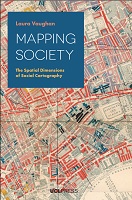Mapping Society
The Spatial Dimensions of Social Cartography
Author(s)
Vaughan, Laura
Collection
Knowledge Unlatched (KU)Number
102005Language
EnglishAbstract
From a rare map of yellow fever in eighteenth-century New York, to Charles Booth’s famous maps of poverty in nineteenth-century London, an Italian racial zoning map of early twentieth-century Asmara, to a map of wealth disparities in the banlieues of twenty-first-century Paris, Mapping Society traces the evolution of social cartography over the past two centuries. In this richly illustrated book, Laura Vaughan examines maps of ethnic or religious difference, poverty, and health inequalities, demonstrating how they not only serve as historical records of social enquiry, but also constitute inscriptions of social patterns that have been etched deeply on the surface of cities.
The book covers themes such as the use of visual rhetoric to change public opinion, the evolution of sociology as an academic practice, changing attitudes to physical disorder, and the complexity of segregation as an urban phenomenon. While the focus is on historical maps, the narrative carries the discussion of the spatial dimensions of social cartography forward to the present day, showing how disciplines such as public health, crime science, and urban planning, chart spatial data in their current practice. Containing examples of space syntax analysis alongside full colour maps and photographs, this volume will appeal to all those interested in the long-term forces that shape how people live in cities.
Keywords
Cartography; Mapping; Society; Social CartographyDOI
10.14324/111.9781787353053ISBN
9781787353053OCN
1076639953Publisher
UCL PressPublisher website
https://www.uclpress.co.uk/Publication date and place
2018Classification
City and town planning: architectural aspects
Society and Social Sciences
Urban communities
Sociology and anthropology
Human geography


 Download
Download